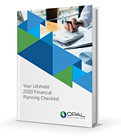5 Retirement Planning Tips for Your 50s
By Jesse Giordano, CFP® | April 27, 2023If you’re in your 50s, chances are you’re on the home stretch of your working years and looking ahead to retirement. As you get closer to leaving the workforce, it’s a great time to take stock of your nest egg and make any necessary tweaks to your retirement savings plan. Thinking about these things now can pave the way for a comfortable lifestyle when you’re no longer working. Below are five retirement planning action items for folks in their 50s.

1. Envision Your Retirement
Think about what you want life to look like in retirement. For some, that may mean frequent travel or even retiring abroad. Others may see themselves enjoying leisure activities and spending more time with family and friends. If you’re partnered, check to see if your significant other is on the same page. If the two of you have different visions for retirement, it’s better to talk those things out sooner rather than later. As a couple, you may have to make some compromises and possibly adjust your savings target.
Whether you’re in a relationship or single, remember that retiring doesn’t just change your financial life. It’s also a social and emotional transition. How will you spend your days when you’re no longer working a full-time job? Some retirees choose to volunteer, work part-time, take up new hobbies, or get more involved in their community. Every person is different, but the idea is to stay socially active and engaged.
2. Estimate How Much Money You’ll Need in Retirement
Once you’re clear on the type of retirement you’d like to have, the next step is figuring out how much that retirement will realistically cost. Your lifestyle, age and retirement goals will determine the right savings target for you. Those retiring before age 65 (and are ineligible for Medicare) will likely need to factor in additional health care costs — which can be significant. It’s an easy detail to overlook, but an important one if you’re planning to retire early.
An experienced financial advisor can help you run different retirement scenarios and ballpark your income needs when you’re no longer working. They can also evaluate your current assets and savings rate to see if you’re on track to meet your goals. If not, you can troubleshoot solutions together. That may involve contributing more to certain retirement accounts. Reviewing Opal’s guide to catch-up contributions is a good place to start.
3. Clarify Your Retirement Income
You’ve got a vision for retirement and a price tag to go with it. Now you need to consider your retirement income sources. That may include:
- Investment accounts: 401(k)s, IRAs, brokerage accounts, health savings accounts (HSAs), etc.
- Passive income streams: That includes dividend-paying stocks and rental income from investment properties.
- Income from side businesses or other investments: If you’re working part-time, running a side business, or have an ownership stake in other businesses, that can generate income in retirement.
- Social Security: You can begin taking Social Security at age 62, but you’ll get the largest benefit if you wait until age 70.
- Annuities: These can help provide guaranteed income for the rest of your life. Purchasing an annuity might make sense if you’re worried about outliving your nest egg.
- Cash value in a permanent life insurance policy: Some life insurance policies accumulate cash as you pay your premiums. You can dip into this cash value to help fund your retirement, though doing so will likely deplete your death benefit if you don’t repay what you borrow.
4. Explore Roth Conversions
If you think you’ll be in a higher tax bracket in retirement, completing a Roth conversion during your working years is one possible strategy. Distributions you take in retirement from a traditional IRA count as taxable income. With a Roth IRA, which is funded with after-tax dollars, distributions are tax-free.
A Roth conversion involves taking money out of a traditional IRA or 401(k), paying taxes on that amount today, then rolling the rest into a Roth IRA. It’s wise to consult a financial advisor because converting too much all at once could land you in a higher tax bracket. They may suggest gradual conversions over several years to minimize the tax consequences.
5. Understand RMD Rules
Some tax-advantaged retirement accounts require you to start withdrawing funds when you reach a certain age. That includes 401(k)s and traditional IRAs. Beginning in 2023, you’ll have to start taking required minimum distributions (RMDs) when you turn 73. (In 2033, the RMD age will increase to 75.) Understanding RMD rules is an important part of retirement planning, which is why we put together this comprehensive Opal RMD guide. If the bulk of your nest egg is in tax-deferred accounts, a large portion of your savings could get eaten up by taxes. While in your 50s, you and your financial advisor can review your assets and start strategizing ways to reduce your tax liability in retirement.
Planning for retirement is an individualized process. No two people are alike, but your 50s can be an ideal time to start getting things in order. Opal Wealth Advisors is here to walk you through every step of the journey. Having a team of financial professionals by your side can help make your retirement dreams a reality.
Be a Smart Investor
Stay up-to-date with industry-leading information and news delivered straight to your inbox.
Get our timely insights delivered to your inbox (Blog)
Please remember that past performance may not be indicative of future results. Different types of investments involve varying degrees of risk, and there can be no assurance that the future performance of any specific investment, investment strategy, or product (including the investments and/or investment strategies recommended or undertaken by Opal Wealth Advisors, LLC [“OWA]), or any non-investment related content, made reference to directly or indirectly in this commentary will be profitable, equal any corresponding indicated historical performance level(s), be suitable for your portfolio or individual situation, or prove successful. Due to various factors, including changing market conditions and/or applicable laws, the content may no longer be reflective of current opinions or positions. Moreover, you should not assume that any discussion or information contained in this commentary serves as the receipt of, or as a substitute for, personalized investment advice from OWA. OWA is neither a law firm, nor a certified public accounting firm, and no portion of the commentary content should be construed as legal or accounting advice. A copy of the OWA’s current written disclosure Brochure discussing our advisory services and fees continues to remain available upon request or at www.opalwealthadvisors.com. Please Remember: If you are a OWA client, please contact OWA, in writing, if there are any changes in your personal/financial situation or investment objectives for the purpose of reviewing/evaluating/revising our previous recommendations and/or services, or if you would like to impose, add, or to modify any reasonable restrictions to our investment advisory services. Unless, and until, you notify us, in writing, to the contrary, we shall continue to provide services as we do currently. Please Also Remember to advise us if you have not been receiving account statements (at least quarterly) from the account custodian.



